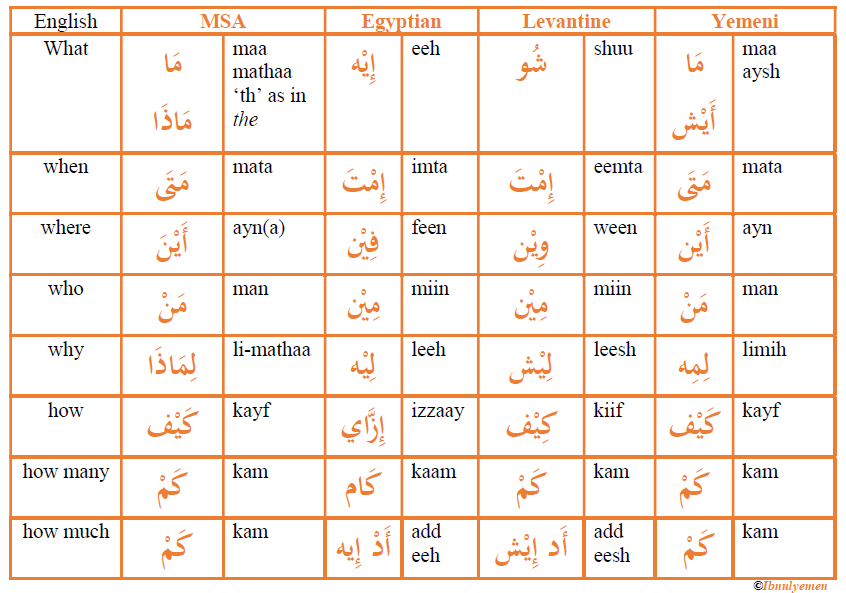Question Words in Arabic [Standard vs Dialects] Posted by Ibnulyemen اِبْنُ اليَمَن on Jul 6, 2017 in Grammar, Pronunciation, Vocabulary
Arabic question words may vary in form from dialect to dialect. They also vary in their position in the sentence. Following is a list of questions words in Modern Standard Arabic, Egyptian dialect, Levantine dialect, and Yemeni dialect.

MSA Examples:
مَا اِسْمُك؟ maa ismuk? ‘what is your name?
مَاذَا تَفْعَل؟ mathaa tafعal ‘what are you doing?
مَتَى تَجِيء؟ mata taji’e ‘when will she come?
أَيْنَ تَسْكُن؟ ayna taskun ‘where do you live?’
مَنْ أَنْتَ؟ man anta ‘who are you?’
لَمَاذَا تَبْكِي؟ li-mathaa tabki ‘why do you cry?’
كَيْف أَنْتَ؟ kayf anta ‘how are you?’
كَمْ السَّاعَة؟ kam as-saعah ‘what time is it?
Egyptian Examples:
اِسْمَك إِيْه؟ ismak eeh ‘what is your name?’
بِتِعْمَل إِيْه؟ bi-tiعmal eeh ‘what are you doing?
حَتِيْقِي إِمْتَ؟ Ha-tiigi imta ‘when is she coming?
سَاكِن فِيْن؟ saakin feen ‘where do you live?’
إِنْتَ مِيْن؟ inta miin ‘who are you?’
بِتِبْكِي لِيْه؟ bi-tibki leeh ‘why do you cry?’
إِزَّايَك؟ izzayyak ‘how are you?’
اِسَّاعَة كَام؟ issahعa kaam ‘what time is it?’
Levantine Examples:
شُوْ اِسْمَك؟ shuu ismak ‘what is your name?’
شُوْ عَم تِعْمَل؟ shuu عam tiعmal ‘what are you doing?
إِمْتَ رَح تِجِي؟ imta raH-tiji ‘when is she coming?
وَيْن سَاكِن؟ ween saakin ‘where do you live?’
مِيْن إِنْتَ؟ miin inte ‘who are you?’
لِيْش عَمْ تِبْكِي؟ leesh عam tbki ‘why do you cry?’
كِيْفَك؟ kiifak ‘how are you?’
كَمْ اسَّاعَة؟ kam assaعah ‘what time is it?’
Yemeni Examples:
مِسْمَك؟ msmak ‘what is your name?’
مَا بِتِعْمَل؟ maa btiعmal ‘what are you doing?
مَتَى عَتِجِيْ؟ mata عtiji ‘when is she coming?
أَيْن سَاكِن؟ ayn saakin ‘where do you live?’
مَنَنْت؟ manant ‘who are you?’
لِلْمِه بِتِبْكِي؟ lilmih btibki ‘why do you cry?’
كَيْفَنْت؟ kayfant ‘how are you?’
كَمَسَّع؟ kamassaع ‘what time is it?’
Note on usage:
As you can see from the examples, in both Levantine and Yemeni dialects, as is the case with MSA, question words come at the beginning of a sentence. In Egyptian, on the other hand, they come at the end of sentences, in particular, short sentences. In Yemeni dialect, the both alif al-wasl and alif al-qafع are assimilated. Hence, we say كَيْفَنْت kayfant instead of كَيْفَ أَنْت kayf ant and مَنَنْت manant in lieu of مَنْ أَنْت man ant.

Build vocabulary, practice pronunciation, and more with Transparent Language Online. Available anytime, anywhere, on any device.




Comments:
Jeannie:
The word أد in the Egyptian and Levantine dialects are really قد. It’s just that in the urban dialects the ق is pronounced like a ء, hamza. In the more rural varieties of Levantine it is pronounce like anhard “g”, as with many Gulf dialects. So it would be gadaysh, in Tunisia they pronounce the ق, so it’s قديش.
Once I knew what it was referring to it, and you know the word for “what” in the dialect, it makes a lot of sense- meaning ” What amount?” Perhaps it is related the word قدر, which means amount, measure, degree.
Ibnulyemen:
@Jeannie You right on the pronunciation of the ق /q/; as for أد, the second thought is more logical as far as I am concerned, i.e. أد is derived from قدر.